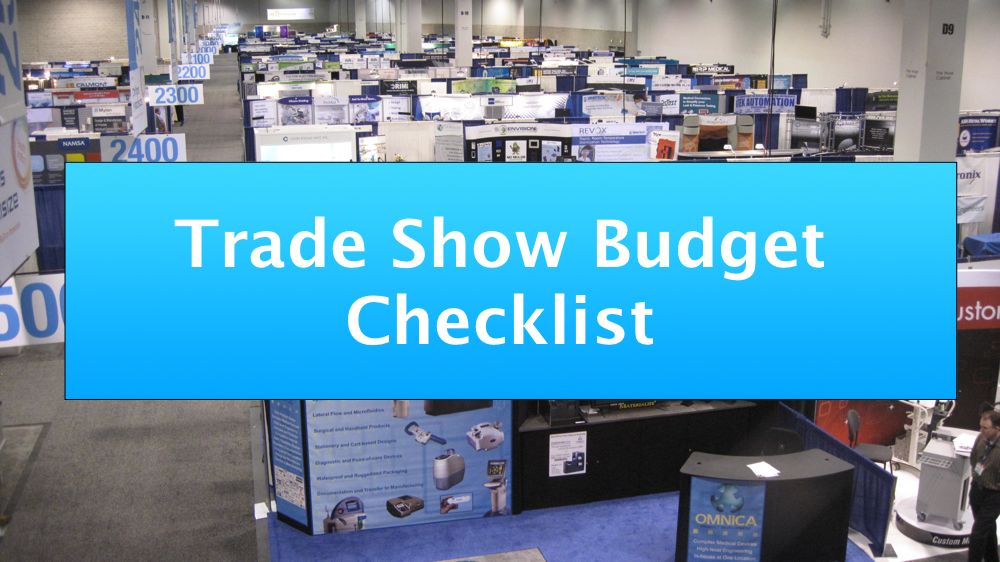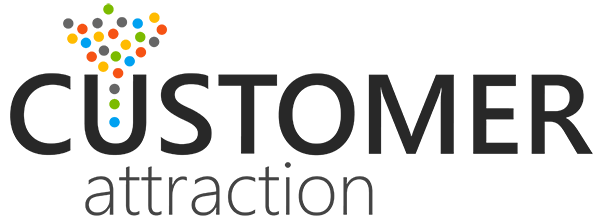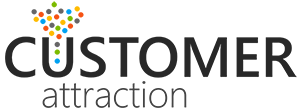
Ultimate Trade Show Budget Check List
How Much Does it Cost to Exhibit in a Trade Show?
I’ve been intimately involved in tradeshows for the past 20 years in one way or another and get this question a lot from customers, clients and peers. So I thought it would be useful to create a straightforward, simple and useful trade show budget checklist that is shareable! Feel free to share it if you find it helpful. If I have forgotten something in the list, please shoot me an email to info at customerattraction dot com.
Your Basic Trade Show Budget – 10 x 10 trade show space
Here are some of the base costs that you might consider when you are making a trade show budget.
Booth space cost (10 x 10 foot booth, $30 per square foot) $3000
Rental carpet, underpad and visqueen (plastic covering) $500
Lead retrieval unit $300
Electricity, simple $200
Mobile app / promotion $100
Drayage (material handing fee at the show, dock to booth) $200
Shipping your booth (2 ways) $400
Show labor $150
Booth cleaning $150
Furniture rentals; other booth fixtures $200
Total $5300
Things to Consider When Budgeting
Staff. You cannot execute a trade show well without good staff in your booth. It is great if you can use your local sales professionals to cut down on travel, but when that’s not possible you will have the typical sales travel costs. For some companies, these costs are truly “sales” costs and not attributed to marketing budgets.
Travel. The average flight cost in the US is approximately $280 USD round trip according to airlines.com. I would always use a range to estimate this cost, as most people in business to business don’t buy the cheapest tickets when reserving for a trade show and often travel is last minute, increasing the flight costs.
Automobile. The average cost to rent a car in the US is approximately $45/day. Again with big cities and popular times, double this number.
Hotel. The average cost of a hotel night in the United States is $137 according to the website Hotels.com Hotel/Price Index and statistica.com. Once again, I would tend to estimate higher numbers especially trade show hub cities like Chicago and New York City, where room costs can double during large events.
Food. Food is usually assigned as a Per Diem (per day) cost for budgeting, and are approximately $50-$75 dollars per city in the US. Bigger cities are typically more expensive, so a higher per diems should be considered.
Entertainment. It is best to make a broad range estimate on entertainment costs for your tradeshow efforts, depending on your sales and marketing strategy for that particular show. Think theatre and show tickets for clients, dinners, drinks or maybe a baseball game.
Pro Tip: make sure that have a hard or soft copy of your booth space contract and all the other “orders” that make up your event. Create a hard copy file folder or a tradeshow binder, where anyone could find the information quickly and easily in the usually chaotic trade show setup, during the show, during tear down, and for shipping. One of the most important and often missing pieces of information is your shipper name and contact information. Make sure to include the commercial invoice, especially if you are shipping internationally.
Here is your ultimate budget checklist for tradeshows:
Trade Show Booth Space Cost — It is a good rule of thumb to assume that nothing comes included with your trade show booth, as is the case with most industrial and business-to-business trade shows. No carpet, no underpad, no electricity, no labor— just raw space. The show owner may give you something called pipe and drape (the loose fabric that separates your booth from your neighbor), and may include a small sign, but usually that is about it. Otherwise, if other elements are included with your booth space, it is called a “package” and includes AC power, some furniture and a garbage pail. Of course, this will be an extra cost.
Constructing / Striking Your Booth — If your booth needs tools to be put together, and takes over 30/60 minutes (or you are not in a right-to-work state) you will need to estimate for this cost. The show contractor can provide the labor to do this for you, or you can elect to choose your own contractor (called an EAC) exhibitor appointed contractor.
Furniture Rentals — Items such as glass cabinetry, table and chairs or other seating for your booth are usually best rented. If you were to purchase and ship, glass most likely wont make the journey and it expensive to crate, dray and timely to construct. Although rental costs are generally exorbitant, sometimes it makes more sense, for this reason, to rent. Time is money at trade shows and the quicker that you can get something done, the less the expense.
Overhead Signs — This shipment of the sign crate usually gets expedited to a special holding area or “advanced warehouse” so the organizer can easily identify the crates that contain the signs. If your sign turns, or has a motor, make sure that you let everyone know and create an “electrical order” for your sign. Usually there is a separate contractor for the electricity and another contractor that will install the sign at the trade show hall. For overhead signs you have the cost of building and installing the overhead sign, installing the electrical motor and connecting it to the hall power.
Electrical order — One of the first and most important trade show orders is your electrical order. It is critical to contract this before the carpet is installed, because the power access and extensions all run underneath. If you have a simple 10 x 10 style booth, you probably don’t need an extensive sketch, but if you have more complex needs or a bigger booth, make sure that you include a sketch or a CAD layout of your booth and what equipment will be in the booth. It’s very useful to include your neighbor’s booth position, with their booth number, so that your electrical gets laid down accurately. Keep in mind that carpet will go over the electrical layout and this is very expensive to change after the fact. Always confirm your orders with all service contractors, and if the layout changes, then insert revision number on the sketch (Rev. 1, Sept 20) with a date. An electrical sketch in Excel for this purpose works just fine. For complex electrical orders consult the electrical contractor to find out if there may be a better way to construct your electrical. They will know the most economical method to ensure your order gets done safely and efficiently. Many high amperage orders get run from the ceilings. You may also need a box on the floor to help distribute power, so think about leaving some floor space for this in your layout.
Carpeting and Underpad — Have the carpet supplier confirm your order, including under pad and a protective plastic cover also sometime called Visqueen. Make sure that you print all these orders and place them in the binder. If for some reason, the contractor does not get your order, you may be hours and hours waiting for labor to put down your carpeting, and I can guarantee you won’t get the color of carpet that you want.
Insurance. Most tradeshow operators will want a proof of insurance certificate weeks before the setup of the show. In North America this is pretty common, and if it is easier, you can buy this insurance through a contractor of the show.
If you have read some of my blogs before, you will know that I really like trade shows. I like shows because I have seen them create huge opportunities for companies. They are motivated to ensure that you have a good event experience. Trade shows work as long as you make them work for you.
Often I get asked, how much does it cost to attend or exhibit in a trade show? A quick calculation I use is take the space cost of a trade show booth and multiply by three; this will give you a good general indicator of the investment of trade show participation costs.
Pro Tip: Avoid overtime. Make sure that you are using a shipping company that has trade show experience, is nationwide, is recommended by the show operator or works out of the event venue. I have been on the receiving end of that upsetting phone call from the driver who had been in line for several hours already telling me that he was now going home. Engage professionals who know the territory.
If you’re fortunate enough to live in town where the trade show is being held, you do not need to transportation. The rules usually state that if your booth doesn’t require tools to be constructed (ie. pop up booth) and takes less than an hour to construct, you can just wheel the booth to your spot in the show, set it up and then you usually can do it without hiring labor. If your booth has no lights, then you may not need electricity. Although I highly recommend lighting; it makes a big difference to visibility of signage and graphics. If you own your own flooring or carpet, then you have no need to rent at the trade event.
I attend a lot of shows that display machinery. For this type of show you need to add additional line items to your show budget. The first element is your drayage or machine haulage fees. This covers the cost of removing the goods from the shipping trailer or truck to your booth. Normally this charge is determined by the weight of your machine. Show contractors charge in 100 weight (hundred-weight) increments. So if the charge is $75 per hundred-weight and your machine or display weighs 1000 pounds then your charge for drayage is $750.
Pro Tip: Have your truck weighed at an independent weigh scale empty and then full. Proof of this will speed up your processing at a trade show hall.
Other charges at shows with equipment:
Compressed Air Service. Remember that air has two components, the air service and the labor to hook up the air). It is always important to know the details, such as the size of the hook up and the air power (per sq ft) that is required.
Wastewater. again you have to pay for the service of wastewater and plumber to hook up for the wastewater charges. At some shows, waste may be treated and charged differently such as waste from machines that have cutting fluids.
Porter Service. In some shows, you may require deliveries or pick-ups during the show. This is usually called “porter service”. This usually applies to small packages, garbage pick up that you may have created in your booth, etc.
Plants and Flowers. I personally like to order plants and flowers at trade show booths. They soften hard displays and can hide unsightly wiring, hoses and tubes, or rough edges.
Machinery Moving. Your booth plan may include machinery or equipment that is too heavy to lift. If you are in the booth, and your machine shows up on a forklift, you simply direct the forklift driver to put the machine or equipment in place where you want it. If you are strategic and show up to your booth early, you will get it “spotted” for free. If you are not so lucky and your machine or piece of equipment needs to be picked up (re-spotted), you will need a forklift, forklift driver, a
spotter/supervisor for safety, depending on venue and show management. This is usually charged by weight and often times they will include the labor. There are different charges for a 5,000 pound forklift vs. a 7,500 pound forklift and of course this depends on your requirements.
Onsite Storage. This service is very convenient if you do not have much room in your booth, or need to have access to important spare parts or consumables during the tradeshow. Note that you will pay to have your particular crates located nearby to the show and you will have to pay for a person to escort you to the crates, each time. This is usually a one hour minimum charge of $70-$100.
Security. Whether you need security for an after-hours party in your booth, or you want security present all night to protect your valuable parts, tools, computer equipment, the cost ranges from $75-$120 per hour, per person.
Internet. If you need high-speed access to the web in your booth, there is usually a telephony contractor that can service your needs. Be prepared; it can be costly (think $200/day). If you really require internet, and really who doesn’t, don’t depend on the hall’s free internet service, especially in big halls where you may have 10,000 or 50,000 visitors. Service is constantly dropped during the day so if it’s a requirement budget for it.
Talent, Greeters, Models. Long gone are the “booth babes”—yes, they were a thing
—- of yesterday; even as recently as the early 2000’s. These mostly women, were hired to attract and greet booth visitors. Now exhibitors often engage temporary help which can have advantages for companies short on staff. These individuals often live in the city, they are approachable, focused and professional. You still have to do your homework and interviews, but they can be a valuable part of your trade show strategy. You will pay $300-$500 per day, per person, depending on the city.
F & B Food and Beverage. Most trade show halls reserve the right to serve food and beverage in their own venue. It promotes the kitchen and the labor that services food in the hall. Note that you will pay for a cheese plate and for the labor to set it up. Most likely this order is done directly with the venue and the tradeshow operator can help set this up. If your show closes at 5 PM, and you decide to have food served in your booth after 5, then you may also have to hire security for the duration. And don’t forget to tip your servers; gratuity is not usually included.
Capital Costs to Include in Your Tradeshow Budget Calculation
Although these are capital costs, they do translate into costs and should be amortized over the life of your exhibit property or at least attached to trade shows that you attend.
Trade Show Booth Graphics. Keeping your booth graphics looking good takes planning, time and energy. This effort should be revisited throughout the year, when your time will be less constrained and you can plan and source them without pressure.
Photography. If you are lucky enough to have a trade show budget that allows for photography, high quality custom photos will serve you well in your trade shows and help tell your story. They are an excellent investment and can be used repeatedly for years.
Pre-Striking your Booth. Setting up your booth (striking) either in your facility or at your tradeshow booth construction company, allows you the chance to view your graphics, check for missing parts, look for any needed repairs like delaminating graphics.
Shipping Crates. Make them yourself, buy them from a company like Jobox or have your trade show booth supplier make them for you. A trade show crate has to endure multiple moves, forks from unfriendly forklifts and has to be made for the long term. The challenge with this is that beefy crates weigh more and will cost you more in shipping and drayage costs.
Thanks for reading to the end. If you have any comments, or if there is anything that I have forgotten, please send me an email at info at CustomerAttraction dot com.
You can join our Customer Attraction email list at www.customerattraction.com/join and we give you lots of tips, tools and inspiration on how to attract more customers at trade shows and in the real world.
Categories
Recent Posts
- Trade Show Rule #1 Always Speak at Trade Shows 03th Jul 2023
- Are You Buying Email Lists? 06th Apr 2023
- Who are the Robot Manufacturers in Canada? 11th Mar 2023

